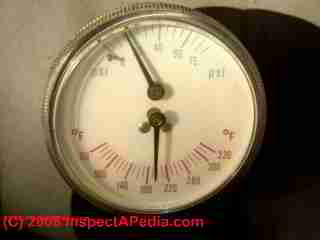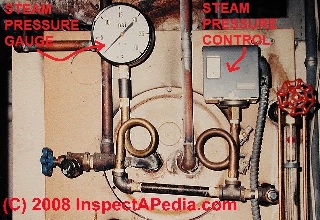|
|
本帖最后由 craftman 于 2012-12-14 08:10 编辑
Hydronic (hot water) Heater Pressure Gauge and Normal Pressure Ranges
 Pressure and Temperature gauge on hot water or hydronic heating boilers: this gauge displays the heating boiler internal pressure and temperature. Pressure and Temperature gauge on hot water or hydronic heating boilers: this gauge displays the heating boiler internal pressure and temperature.
Typical pressure for a residential boiler serving a two story home would show 12 psi cold, and less than 30 psi hot. Over 30 psi boiler pressure will cause the pressure relief valve to open.
Typical operating temperature settings on a boiler call for a Low temperature (boiler cut-in) between 120 and 160 degF.
Typical operating temperatures on a hydronic boiler call for a high temperature (boiler cuts off) of 180-200 degF.
Over 200 degrees F. we're at risk of spilling at the pressure temperature relief valve.
|
 Typical operating temperature observed at the gauge will be below the high, and can be as low as nighttime room temperature in non-heating season if no tankless coil is in use. Typical operating temperature observed at the gauge will be below the high, and can be as low as nighttime room temperature in non-heating season if no tankless coil is in use.
The temperature/pressure gauge may help in checking for normal conditions before and during boiler operation.
However the gauge can be wrong!
This gauge shows a typical in-boiler pressure of under 20 psi, and a temperature of about 190 degF. (The boiler had just cut off on a heating cycle.)
|
What Are the Normal Hot and Cold Operating Pressures of Residential Hydronic (hot water) Heating Boilers?On a residential heating boiler the automatic water-feeder/pressure reducing valve that automatically provides makeup water to the heating boiler if pressure drops below 12 psi. So 12 psi is the typical "cold" pressure for residential boilers.
If your building is taller than two floors, the installer may have needed to boost the starting "cold" water pressure for your boiler to overcome the hot water distribution piping head pressure - otherwise your heating circulators may not be able to circulate hot water.
At PUMP, WATER PRESSURE BOOSTING we explain the relationship between building height and water pressure, and we illustrate the water pressure decrease in building water supply piping with building height. But a look at the basement water pressures in this illustration also explains the pressures that a basement located hot water heating circulator pump has to overcome.
12 psi is for typical U.S. / Canadian residential heating systems normal cold temperature starting pressure. U.K. and european heating systems should be pressurized to between 1 and 1.5 bar - cold.
20 psi is typical for U.S. / Canadian residential heating systems normal hot operating temperature, up to just under 30 psi, depending on the high-limit temperature setting on the boiler limit control. If we set the boiler high-limit much over 210, on many residential systems the system pressure will exceed 30 psi and we'll see water leaking from the pressure/temperature relief valve - ultimately an unsafe condition.
Where & How do I Set Boiler or Furnace Temperature?Remember that the building THERMOSTATS set the desired temperature in the occupied spaces in building, not the actual temperature in the heating boiler or furnace itself. In most heating systems, turning up the thermostat simply causes the boiler or furnace to turn on. The temperature at the boiler or furnace is controlled by local safety devices mounted right at that equipment.
For more diagnostic aid on finding the cause and executing the cure of abnormal heating boiler pressures see
Steam Boiler Pressure Gauge and Normal Pressure Ranges  Pressure and Temperature gauge on steam heating boilers: Residential steam heating systems are almost always designed to operate at very low pressures, perhaps around .5 psi - that' s 1/2 of one psi. Pressure and Temperature gauge on steam heating boilers: Residential steam heating systems are almost always designed to operate at very low pressures, perhaps around .5 psi - that' s 1/2 of one psi.
You should see similar settings on the pressure gauge (at left in our photograph) and on the steam pressure control switch (the gray box at right in our photo) on your boiler.
The controls in this photo are discussed in detail at [size=-1]STEAM HEATING SYSTEMS and in detail at [size=-1]Steam Pressure Gauge
|
What Are the Normal Hot and Cold Operating Pressures of Residential Steam Heating Boilers?Residential steam heating systems are almost always designed to operate at very low pressures, perhaps around .5 psi - that' s 1/2 of one psi.
If your residential steam boiler is operating at higher pressures (take a look at the dial setting on your Pressure Switch, Steam Boiler) , that may be an indication that a service technician or owner was having trouble getting heat distributed through the building. Rather than finding and fixing the problem, someone is trying to "force" the steam around the system.
An experienced steam heat service technician will look at the operating pressure of your steam heating boiler and if it is not set to a normal level, the technician will look for the reason. Examples of problems that can affect the flow of steam heat through the system, leading to attempts to over pressurized the system include
- Blocked condensate returns at individual steam radiators
- Steam radiators tipped the wrong way
- Improperly relocated steam piping that has the incorrect slope
- Radiator valves that are not operating,
- Radiator steam vents that are not operating properly - Steam Vents
For details about radiator problems see [size=-1]RADIATORS and see LEAKS at BASEBOARD, CONVECTOR, RADIATOR. Also see HEATING LOSS DIAGNOSIS-BOILERS. More about steam boiler gauges is at Steam Pressure Gauge.
Hot Water Heating System Controls Inspection, Peripherals, Key Components
How to determine what type of heating system is installed:
Warm Air Heating Systems - Furnaces: If the heat in your building is provided by warm air that flows out of ceiling, wall, or floor air supply registers into the occupied space, or if your heating system uses a water-to-air heating system then the air which warms the living space is probably being delivered through large or small diameter ducts, registers, air filters, and a furnace blower, and the air is being heated by a gas, oil, or electric furnace, or perhaps by a heat pump or a geo-thermal system. See FURNACE CONTROLS & SWITCHES and for details see FURNACE OPERATION DETAILS.
Hot Water or Steam Heating Systems - Boilers: If the heat in your building is provided by warm or hot metal radiators, heating baseboards containing finned copper tubing, or wall convectors that look like a radiator but contain finned copper tubing, or if heat is provided by flexible rubber, plastic, or metal tubing run in building floors or ceilings, then the warm or hot water circulating in those devices is probably being delivered by piping circulating water heated by a heating boiler, or possibly by a steam boiler or a heat pump or geo-thermal system. See BOILERS, HEATING and RADIANT HEAT Floor Mistakes to Avoid.
If your heating radiators have valves which hiss and let air escape as heat is coming on your heat is probably being delivered in pipes which circulate steam from the steam boiler up through radiators in the occupied space. See STEAM HEATING SYSTEMS .
This website provides description of all of the major components of hot water or steam heating systems, how to recognize or find each component, what it looks like, what goes wrong, and how to maintain, repair or adjust the component.
From: InspectAPedia® |
|